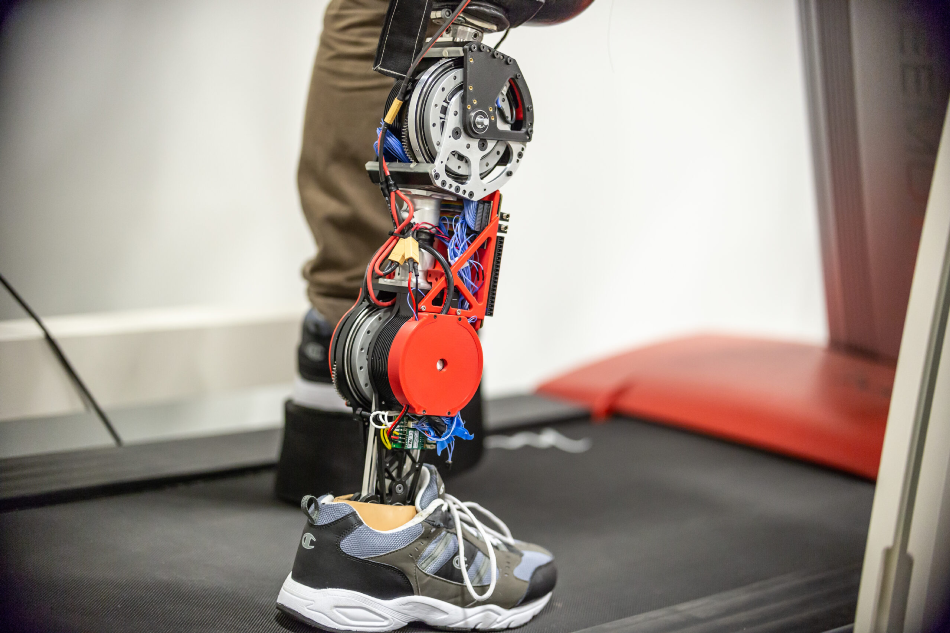Jul 16 2020
Researchers have developed a prototype of robotic prosthetic leg that provides a more natural gait, works noiselessly and more efficiently when compared to other kinds of designs.
 A student tests the robotic leg at the University of Texas at Dallas. The strong motors powering the knee and ankle can propel the user’s body while allowing the knee to swing freely, with regenerative braking to extend battery life. Image Credit: University of Texas at Dallas.
A student tests the robotic leg at the University of Texas at Dallas. The strong motors powering the knee and ankle can propel the user’s body while allowing the knee to swing freely, with regenerative braking to extend battery life. Image Credit: University of Texas at Dallas.
New tiny and robust motors, which were originally developed for a robotic arm on the International Space Station, are the main components behind this innovation. A free-swinging knee and regenerative braking are included in the streamlined design. These mechanisms charge the battery by using the energy that is captured when the foot touches the ground.
This trait allows the prosthetic leg to more than double the walking needs of a regular prosthetic user with just a single charge each day.
Our prosthetic leg consumes approximately half the battery power of state-of-art robotic legs, yet can produce more force.
Robert Gregg, Associate Professor, Department of Electrical and Computer Engineering, University of Michigan
Gregg is also a member of the Robotics Institute at the University of Michigan and headed the research while he was at the University of Texas at Dallas. He later moved to the University of Michigan last year.
In traditional prosthetics, amputees lift their prosthetic feet from the floor and move their legs forward by raising their hips. But this gait is unnatural and requires more energy than that of normal walking. It also causes more pain and stress in the lower back and hips, and ultimately impairs the joints.
By contrast, robotic legs are capable of providing a relatively more comfortable gait, but one major disadvantage is that they cause stiffness in the joints.
We designed our joints to be as compliant, or flexible, as possible. Our robotic leg can perform and even react like a human joint would, enabling a naturally free-swinging knee and shock absorption when contacting the ground.
Toby Elery, Study First Author and Doctoral Graduate, University of Texas at Dallas
In robotic legs, motors need to be accommodated into the space that would be taken up by an ordinary limb. This involved using tiny motors that rotate rapidly and then employing an array of gears to transform the rapid spin into a stronger force.
The issue is that these gears add weight, are inefficient and noisy, and make it more difficult for the joints to swing. Gregg’s research team has now resolved this problem by integrating more powerful space station motors—one powering the ankle and the other powering the knee.
The use of fewer gears offers several advantages. For example, apart from allowing the free-swinging knee, the removal of gears brings down the noise level from the scale of a vacuum cleaner to a refrigerator. The regenerative braking also absorbs some of the shocks that occur when the prosthetic foot touches the ground.
“If the joints are stiff or rigid, the force is transferred to the residual limb, and that can be painful,” added Gregg. “Instead, we use that force to charge the battery.”
According to the amputees who tested the prosthetics in Gregg’s laboratory, they can sense the leg that helps them to push off the ground as they walk.
In some cases, they have observed that they feel like muscles in their hips and back are working less with our leg, compared to their conventional leg. We’re able to reduce compensations at the hips.
Robert Gregg, Associate Professor, Department of Electrical and Computer Engineering, University of Michigan
The next step for researchers is to enhance the control algorithms that can assist the prosthetic leg to automatically adapt to different types of terrains, transitions between different kinds of activities, and variations in pace.
The study has been published in the IEEE Transactions on Robotics journal. It was financially supported by the National Science Foundation, the National Institutes of Health, and Burroughs Wellcome Fund.
The University of Texas at Dallas and the University of Michigan are mutually pursuing patent protection. As Gregg continues his research, the Tech Transfer of the University of Michigan is actively looking for commercial associates to help launch the novel technology in the market.
Robotic leg uses space-station-inspired motor design for more efficient, natural gait
Video Credit: University of Michigan.
Journal Reference:
Elery, T., et al. (2020) Design and Validation of a Powered Knee–Ankle Prosthesis With High-Torque, Low-Impedance Actuators. doi.org/10.1109/TRO.2020.3005533.